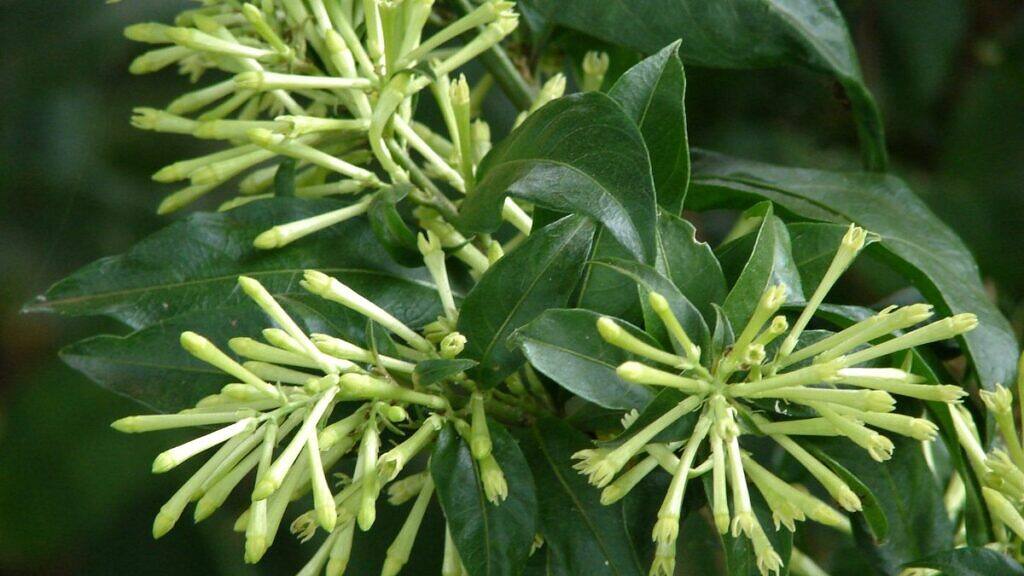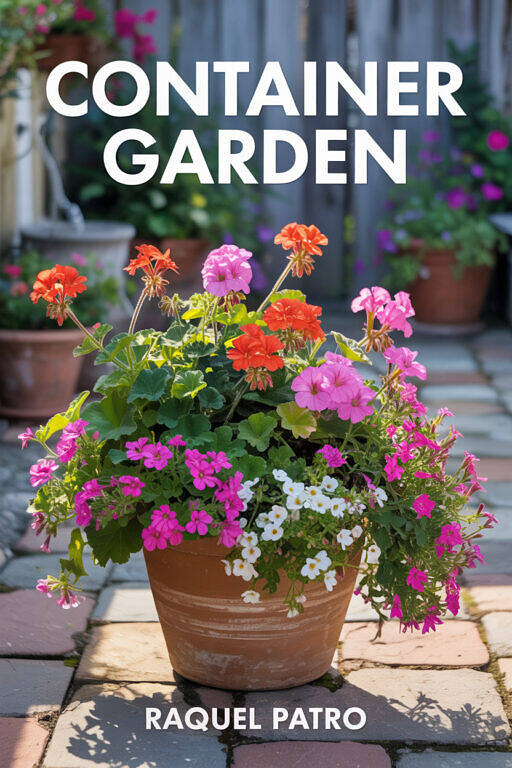Night Blooming Jessamine (Cestrum nocturnum), or just Night Jessamine, is a flowering shrub that awakens the senses as the sun sets. Its discreet flowers during the day transform into a powerful source of intoxicating perfume at dusk, thereby conquering tropical and subtropical gardens around the world. This unique nocturnal behavior, combined with its shiny dark green foliage, has made the species a preferred choice for landscaping projects, especially in living fences and ornamental clusters.
Originally from the Americas, the plant has expanded its presence to regions such as the Caribbean, southern United States, Australia, New Zealand, and southern China, where its adaptability is as impressive as it is concerning – in some places, it has become invasive due to its colonization ability. Beyond its ornamental value, the species carries traditional medicinal uses and serves as an efficient natural barrier.
The scientific name Cestrum nocturnum has been cited in botanical literature since the 18th century, having been described by Carl Linnaeus in 1753. The genus name Cestrum originates from the Greek ‘kestron‘, meaning ‘point’ or ‘engraving tool’, a term used by Dioscorides for aromatic plants. The specific epithet ‘nocturnum‘ comes from Latin and refers to the flowering habit and release of perfume at night. The binomial name highlights both the morphology and nocturnal behavior of the species’ flowers.
Cestrum nocturnum is native to the Antilles, Mexico, Belize, Costa Rica, El Salvador, Guatemala, Honduras, Nicaragua, Panama, and Cuba. It naturally occurs in humid forests and dense vegetation areas or edges of tropical and subtropical woods. It prefers environments with high humidity and well-drained soils, and can form dense, impenetrable thickets when naturalized outside its original area. The species adapts to altitudes ranging from sea level to about 5900 feet (1800 meters). In natural environments, it integrates into ecosystems rich in biodiversity and plays a significant role in nighttime pollination.

Photo by Cary Bass
Despite its common name “Night Blooming Jessamine,” Cestrum nocturnum is absolutely not a true jasmine and bears no botanical relationship to plants in the Jasminum genus. This fragrant shrub belongs to the Solanaceae family (nightshades), making it more closely related to tomatoes, potatoes and tobacco than to actual jasmines, which are members of the Oleaceae family. The confusion arises from the plant’s intensely sweet, jasmine-like fragrance that it releases during nighttime hours, leading to the misleading common name. While both plants share the characteristic of producing highly aromatic white flowers, Cestrum nocturnum can be distinguished from true jasmines by its tubular flower structure, berry-like fruits, and its classification within an entirely different plant family.
Botanical Description of Night Blooming Jessamine
Night Blooming Jessamine is a semi-woody shrub with a branched structure from the base. Its height varies between 4.9 and 11.5 feet (1.5 and 3.5 meters), and it can reach up to 16.4 feet (5 meters) under ideal conditions, with a proportionally dense width. The stems are cylindrical, slender, green to grayish in color, with a diameter generally less than 0.8 inches (2 cm); they have a smooth texture when young, becoming slightly rough over time. The growth is fast to moderate, with abundant branching and a tendency to form compact bushes. Its branches are sinuous, initially erect but become pendant to slightly arched at the tips.
The leaves are simple, arranged alternately along the branches, with a lanceolate or oblong-ovate shape. They measure between 2.4 and 5.9 inches (6 and 15 cm) in length and 0.8 to 1.8 inches (2 to 4.5 cm) in width, featuring an acuminate apex and a rounded or obtuse base. The color is dark green and shiny on the upper surface and lighter on the underside; the veins are especially evident on the back. The edges are entire and smooth, without serration. The petioles are 0.3 to 0.8 inches (0.8 to 2 cm) long, glabrous; the leaves are persistent (evergreen), leathery, and generally have a smooth and glossy surface.

Cestrum nocturnum is a monoecious species, featuring hermaphroditic flowers gathered in terminal or axillary raceme or short panicle inflorescences. The flowering is abundant and occurs mainly in the spring and summer. The inflorescences are dense, composed of numerous tubular flowers ranging in color from yellowish-green to greenish-white. The flowers exhibit radial symmetry, a bell-shaped calyx with five short lobes, and an elongated tubular corolla (0.55–0.79 inches or 14–20 mm), expanding at the upper third. They emit a strong fragrance at night as their purpose is to attract nocturnal pollinators such as moths and bats. The fruit is a white, translucent (sometimes elliptical) globular berry, measuring about 0.28–0.39 inches (7–10 mm) in length; it is not edible due to the plant’s toxicity. Each fruit contains three to eight irregular, small seeds (0.12–0.24 inches or 3–6 mm).
About Night Blooming Jessamine
Night Blooming Jessamine is known for the intense nighttime fragrance of its flowers, whose scent is so distinctive that it can be detected from over 328 feet (100 meters) away. Compounds such as benzaldehyde, phenylacetaldehyde, and benzyl acetate form the aromatic complex responsible for this striking fragrance, which acts as a powerful attractant for nocturnal pollinators. As a member of the Solanaceae family – the same as tomatoes and potatoes – the plant shares important biochemical characteristics with its cultivated relatives, including the presence of alkaloids in all its parts.
The toxicity of the species represents a crucial aspect to consider, especially in home gardens. Studies have identified alkaloids such as nicotine, nornicotine, cotinine, and myosmine in the plant’s chemical composition, substances that confer toxicity both through ingestion and prolonged inhalation. Individuals with respiratory sensitivities or asthma may experience breathing difficulties, nasal and throat irritation, headaches, and nausea when exposed to the intense perfume, likely due to the presence of chlorogenic acid, while accidental ingestion of the fruits can cause feverish symptoms and other health issues in people and animals.

Paradoxically, the same chemical composition that makes the plant dangerous also sparks interest in medicinal and ethnobotanical research. In traditional Mexican medicine, extracts from the leaves are used as antispasmodics, particularly in the alternative treatment of epilepsy, although such uses are limited by the species’ inherent toxicity.
Ethnobotanical records document the ritualistic use of the plant by shamans in Nepal, who report mild psychoactive effects in spiritual experiences, practices that are rare and little studied scientifically.
Night Blooming Jessamine in Landscaping
In landscaping, Night Blooming Jessamine is primarily used as an ornamental shrub due to its fragrant flowering during the nights of spring and summer. It can be used alone as a focal point in tropical or subtropical gardens, or in rows forming dense hedges that act as visual and olfactory barriers. Its erect and branched stature allows cultivation alongside walls or land boundaries, with a striking effect when planted in groups to enhance rest areas or passages. Its multi-stemmed and flexible growth offers versatility, allowing it to be grown as a small tree, shrub, and even similar to a climber. It is recommended to avoid planting near bedroom windows or indoor areas due to the intense fragrance that may bother sensitive individuals.
Night Blooming Jessamine can be combined with species of contrasting foliage or eye-catching but unscented flowers to balance the visual and olfactory impact in gardens. It is an excellent option for attracting nocturnal pollinators such as moths and bats, contributing to local biodiversity. It is not recommended for indoor decoration due to the toxicity of the plant parts and the penetrating aroma of the flowers in enclosed spaces, which can become bothersome and nauseating over long periods.

How to Grow Night Blooming Jessamine
Night Blooming Jessamine thrives best in full sun or partial shade, also tolerating environments with filtered light, but displaying more intense flowering under greater sunlight. Thus, we can soften its perfume, which can be very intense, by planting it in semi-shaded locations. It prefers tropical and subtropical climates, being sensitive to frost and intense cold, with ideal growth at temperatures between 64°F and 90°F (18°C and 32°C). It does not tolerate long periods of temperatures below 41°F (5°C), which can damage branches due to cold winds or strong gusts. In coastal regions, it shows good resistance to maritime conditions, provided it is protected from direct salty winds. Cultivation in areas protected from strong winds favors the vigorous development of the plant.
The ideal soil for growing Night Blooming Jessamine should be fertile, well-drained, and have a light to medium texture; clay and heavy soils should be enriched with organic matter to improve drainage. The most suitable pH ranges from 6.0 to 7.5. In pots, it is recommended to use a substrate composed of garden soil, coarse sand, and worm castings in equal parts. Watering should be regular, keeping the soil slightly moist without waterlogging; short periods of drought are tolerated by well-established adult plants, but excess water can cause root rot. The frequency of watering varies with the climate: in hot and dry regions it may be daily; in humid places or in winter, watering should be reduced.
Planting seedlings should ideally be done at the beginning of the rainy season or during mild periods, ensuring good root establishment before the intense summer or harsh winter. It is recommended to fertilize every six months with organic compost or balanced NPK (10-10-10), enhancing fertilization in the spring to stimulate flowering. Staking is rarely necessary due to the erect shrub form; however, young plants may benefit from temporary support until the root system is established. Annual pruning after flowering stimulates new growth and maintains a compact shape; removing wilted inflorescences prolongs the flowering cycle. Applying organic mulching around the base helps conserve moisture and control weeds.

Night Blooming Jessamine has a low incidence of serious pests due to the natural toxicity of its tissues; however, it may occasionally be attacked by scale insects, aphids, or mites in very dry or poorly ventilated environments. Control can be achieved with sprays of mineral oil or diluted neutral soap. The plant is rarely targeted by herbivory from domestic mammals due to its high toxicity to animals. Root rot can occur in waterlogged soils; avoiding excess water is crucial as a preventive measure.
How to Propagate Night Blooming Jessamine
Propagation of Night Blooming Jessamine is mainly done by cutting semi-woody branches taken after flowering; each cutting should be about 4 inches (10 cm) long and have at least two visible nodes. Cuttings should be planted in moist potting mix and kept in partial shade until rooting, which generally occurs between four and eight weeks. Seeds can also be used, but they exhibit slow and irregular germination; it is recommended to sow immediately after harvesting the ripe fruits. The best time for propagation is from late summer to early fall or in early spring. Plants propagated by cuttings may flower in the first year after being permanently planted in the garden; through seeds, flowering usually occurs between two and three years after germination.


